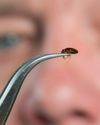This is a question you want answered before booking a trip. We look at the rigorous tests that planes undergo to ensure that flying remains one of the safest modes of transport.

NEIL ASHTON IS AN AEROSPACE ENGINEER AND SENIOR RESEARCHER AT THE UNIVERSITY OF OXFORD’S E-RESEARCH CENTRE.
Air travel is more popular than ever – last year saw more than 1.5 million flights pass through the UK alone. Although aeroplanes have made it easier for us to explore the world, nearly one in three of us claims to be anxious or fearful of flying. Is this fear justified?
US statistics taken from between 2000 and 2009 show that car drivers or passengers suffer 7.3 deaths per billion miles. In contrast, air travel comes in at just 0.07 deaths per billion passenger miles. Of course, statistics can’t cure someone’s fear of flying, but they do prove that it’s one of the safest ways to get from A to B. This safety is thanks to the testing that every single part of the aircraft has to go through before it’s allowed to undertake its first flight.
In the freezer
While passengers get to enjoy the comfort of air conditioning, the engines have to be able to cope with temperatures as low as -55°C during cruise conditions. Here, one of the latest engines is being pushed to its limits at a General Electric testing facility in Winnipeg, Canada. It’s being blasted with icy water from hundreds of nozzles at sub-zero temperatures to check that it will maintain power in cold environments. Temperature tests are important to the airlines because they want to make sure that their planes can operate in as many environments as possible. Each time they have to ground an aircraft because of bad weather, they lose money.
Turbulent times
This story is from the {{IssueName}} edition of {{MagazineName}}.
Start your 7-day Magzter GOLD free trial to access thousands of curated premium stories, and 9,000+ magazines and newspapers.
Already a subscriber ? Sign In
This story is from the {{IssueName}} edition of {{MagazineName}}.
Start your 7-day Magzter GOLD free trial to access thousands of curated premium stories, and 9,000+ magazines and newspapers.
Already a subscriber? Sign In

TAKE IT SLOW
Slow running is a fitness trend with some hard and fast science behind it

Physics, AI and music share a common thread. You just have to know where to look
Studying science can lead you in many directions and open doors to unexpected possibilities along the way

BED BUGS VS THE WORLD
When bloodthirsty bed bugs made headlines for infesting Paris Fashion Week in 2023, it shone a spotlight on a problem that's been making experts itch for decades: the arms race going on between bed bugs and humans

Kids are the key to understanding obesity. But we need more of their genes...
We can unravel the role that bodyweight plays in disease, but we need a bigger, more diverse, sample of genetic material to do so

COVID inquiry: What did we learn and what can we do better in future pandemics?
Masks, social distancing, lockdowns... how effective was the UK's response to the COVID-19 pandemic?

One hormone could be the key that unlocks a cure for morning sickness
The nausea and vomiting that, in extreme cases, can endanger mothers and babies might soon be just a memory

THE WORLD'S WEIRDEST CREATURES
Under the sea and upon the land, some animals look - to us - pretty strange...

WHEN MIND AND MACHINE COLLIDE
First, Elon Musk wanted to make electric cars ubiquitous, then he wanted to make space exploration a private enterprise. Now, with Neuralink, his newest venture, Musk hopes to merge humans and artificial intelligence. Turns out, it might not be such a crazy idea...

COME OUT OF YOUR SHELL
Social anxiety is more than just being shy. It's a phobia born out of our evolutionary past. But that raises a puzzling question: why do so many of us fear human interaction when we're supposed to be the most sociable species on the planet?

SPACE ODDITIES
Take a tour of the weirdest spots in the universe, where the 'normal' rules don't apply. Places that squeeze time, blow bubbles and even rain glass... sideways